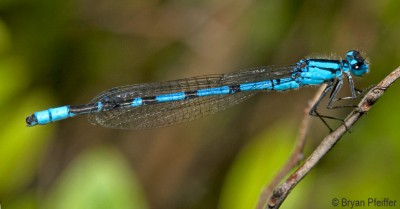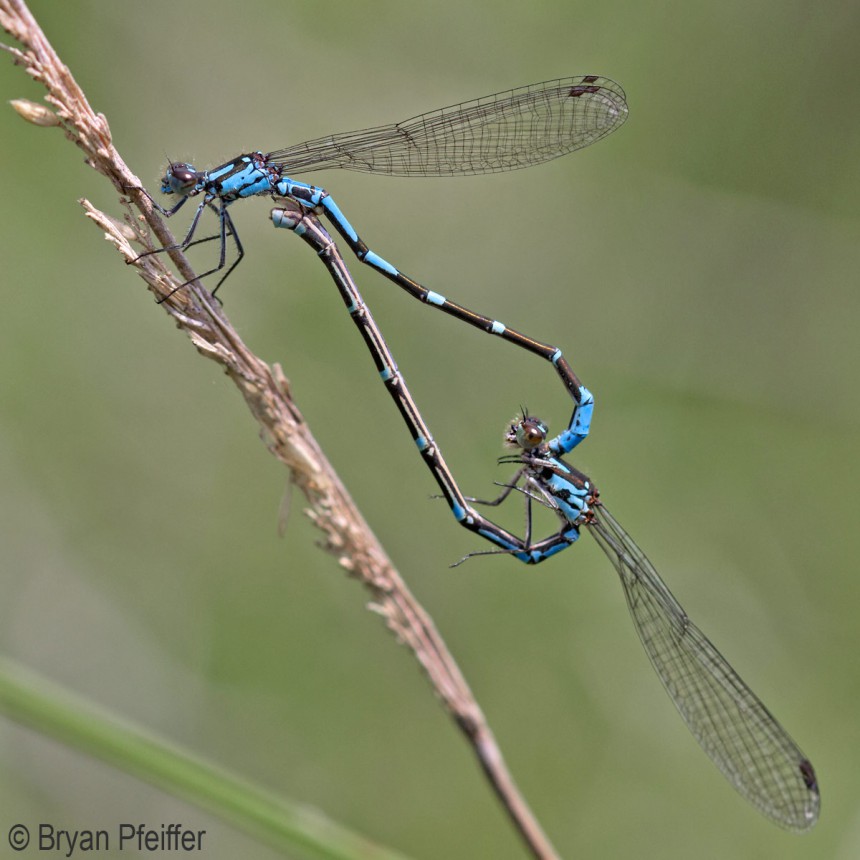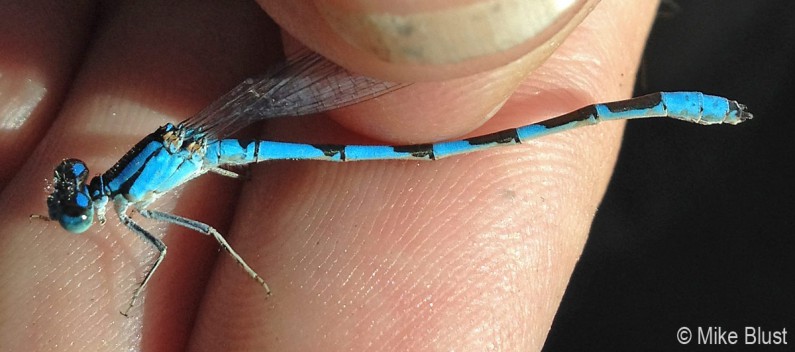A New Vermont Damselfly
THE DIVERSITY OF LIFE IN VERMONT, at least what we know of it, is now a bit richer. Nine days after the discovery of a dragonfly not previously known from the state, we have a new damselfly as well: River Bluet (Enallagma anna). Yeah, that’s the beast above – at least an essential part of him. Mike Blust and Laura Gaudette found this damselfly on the Ompompanoosuc River in Thetford on Monday. You may recall that Laura achived notariety for discovering that new dragonfly earlier this month – Banded Pennant.
Many of you know these bluets. They’re the dainty damsels – about an inch long – that float at pond edges and streamsides. Sometimes they’ll land on your canoe or kayak. To your right is a typical bluet species, Boreal Bluet (Enallagma boreale) from a bog in northern Vermont.
Bluets embody insect diversity. And a general rule of insect diversity is that rarely is there ever just one. We don’t have only one kind of firefly in Vermont; we have about 20 different firefly species. We don’t merely have bumblebees in Vermont; we have roughly 15 distinct bumblebee species.
And now we have a 17th bluet species.
Most bluet species are indeed blue and black. Some of them appear so similar in their patterning (or “plumage” for birders) that we can’t easily tell them apart. As a result, we net ’em and have a closer look at their, well, at their private parts.
That’s what Mike and Laura did on Monday. It’s routine. You see some bluets, and if you don’t have binoculars or you’re past 50 and forgot your eyeglasses, you net a few and have a look at their “appendages,” their nasty bits. It’s our idea of a good time on a lake or river.
 Pictured to the left are the terminal ends of various male bluet species; among many, the most distinctive characteristic isn’t the color pattern, but rather those odd, clamp-like appendages. Those appendages are what we seek out when we identify these little blue damselflies.
Pictured to the left are the terminal ends of various male bluet species; among many, the most distinctive characteristic isn’t the color pattern, but rather those odd, clamp-like appendages. Those appendages are what we seek out when we identify these little blue damselflies.
When he netted a bluet on the Ompompanoosuc, Mike fully expected it to be one of the common species we find all summer in Vermont. But the moment Mike looked at the appendages through his magnifying lens, the known biological diversity of Vermont changed forever. What Mike saw is what you see in the photo at the top of this blog post. In fact, we don’t even need to see the rest of the bug to know that Mike had caught Vermont’s first River Bluet. That mitten-like shape of the top appendage is diagnostic. It says River Bluet. It says it all. And nothing says it all like sex.
Males use those appendages while mating – basically as a clamp for holding females during copulation. Because many bluet species look a lot alike, and many different species can consort like folks at a nudist colony, the clamp ensures that he’s mating with a female of his own kind, a female of his own species. His clamp (actually called cerci and paraproct) fits only with the female of his species. It’s like a lock-and-key system to certify that he’s hooked up with the right female. If the clamp don’t fit, you must, uh, quit. (Sorry.)
When it fits, he’s clamped to the top of her prothorax, a section of the body behind her head – it appears he’s got her by the scruff of her neck. I’m planning a longer blog post to describe what happens next. But some of you already know – and many of you have seen dragonflies or damselflies in what we call the “copulatory wheel.”
Here’s a pair of Subarctic Bluets (Coenagrion interrogatum) in that wheel, with the male “on top” and his appendages clamped firmly behind the female’s head. These two are also linked below his mid-section, where he’s transfering sperm to the tip of the female’s abdomen. Below this dirty insect image is a photo of Mike and Laura’s now-famous River Bluet (Enallagma anna) in the hand.
By the way, I’ll see if I can determine who was the Anna for which this damselfly is named. In any event, Mike says, “Somehow it seems odd to be flaunting anna’s male parts.”





Stand aside, Kinsey and Masters and Johnson; Pfeiffer is now calling the tune!
Very neat. Congratulations Mike!
I saw my first one today….thought it was a dragon fly on a diet! Glad to know the real name!